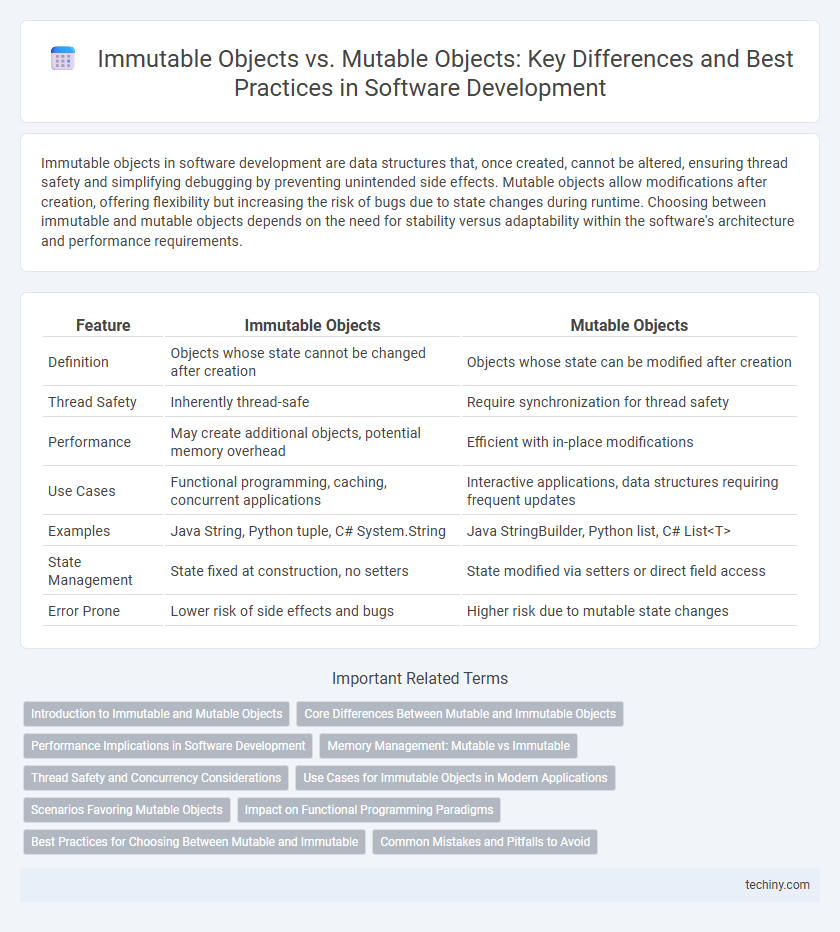Immutable objects in software development are data structures that, once created, cannot be altered, ensuring thread safety and simplifying debugging by preventing unintended side effects. Mutable objects allow modifications after creation, offering flexibility but increasing the risk of bugs due to state changes during runtime. Choosing between immutable and mutable objects depends on the need for stability versus adaptability within the software's architecture and performance requirements.
Table of Comparison
| Feature | Immutable Objects | Mutable Objects |
|---|---|---|
| Definition | Objects whose state cannot be changed after creation | Objects whose state can be modified after creation |
| Thread Safety | Inherently thread-safe | Require synchronization for thread safety |
| Performance | May create additional objects, potential memory overhead | Efficient with in-place modifications |
| Use Cases | Functional programming, caching, concurrent applications | Interactive applications, data structures requiring frequent updates |
| Examples | Java String, Python tuple, C# System.String | Java StringBuilder, Python list, C# List<T> |
| State Management | State fixed at construction, no setters | State modified via setters or direct field access |
| Error Prone | Lower risk of side effects and bugs | Higher risk due to mutable state changes |
Introduction to Immutable and Mutable Objects
Immutable objects are data structures whose state cannot be modified after creation, ensuring thread safety and predictable behavior in software development. Mutable objects allow state changes, providing flexibility but requiring careful management to avoid side effects and bugs. Choosing between immutable and mutable objects impacts code maintainability, concurrency control, and performance optimization in modern applications.
Core Differences Between Mutable and Immutable Objects
Immutable objects cannot be modified after their creation, ensuring thread safety and predictable behavior in concurrent programming environments. Mutable objects allow changes to their state, offering flexibility but requiring careful management to avoid side effects and data inconsistencies. Core differences include memory management, with immutable objects often enabling optimization through caching and recycling, while mutable objects may demand more complex synchronization mechanisms.
Performance Implications in Software Development
Immutable objects enhance thread safety and reduce synchronization overhead, leading to improved performance in concurrent environments. Mutable objects allow in-place modifications, which can minimize memory usage and object creation, benefiting performance in single-threaded applications. Choosing between immutable and mutable objects depends on the application's concurrency needs and memory management priorities.
Memory Management: Mutable vs Immutable
Immutable objects enhance memory management by allowing safe sharing across multiple threads without the need for synchronization, reducing memory overhead through interning and reusing instances. Mutable objects require careful handling to avoid unintended side effects, often leading to increased memory allocation for copies and state tracking. Choosing immutable objects in software development optimizes memory usage and improves application stability by minimizing bugs related to shared state modifications.
Thread Safety and Concurrency Considerations
Immutable objects inherently provide thread safety by preventing state changes after creation, eliminating the need for synchronization in concurrent environments. Mutable objects require careful management using locks or other concurrency controls to avoid race conditions and ensure data integrity. Choosing immutability reduces complexity and improves reliability in multi-threaded software development.
Use Cases for Immutable Objects in Modern Applications
Immutable objects are essential in modern software development for ensuring thread safety in concurrent applications, as their state cannot be altered after creation, preventing race conditions. They are frequently used in functional programming paradigms, where predictable behavior and referential transparency improve debugging and testing processes. Immutable data structures also optimize caching mechanisms and facilitate state management in frameworks like React and Redux, enhancing application performance and maintainability.
Scenarios Favoring Mutable Objects
In software development, mutable objects are favored in scenarios requiring frequent state changes, such as real-time data processing or interactive user interfaces. Mutable objects improve performance by enabling in-place modifications, reducing memory overhead compared to creating new instances for every change. They are essential in algorithms involving iterative updates, where mutability streamlines state management and enhances efficiency.
Impact on Functional Programming Paradigms
Immutable objects enhance functional programming paradigms by ensuring data consistency and enabling pure functions that avoid side effects, which simplifies debugging and testing. Mutable objects, while offering flexibility in state changes, can introduce unintended side effects and complicate reasoning about code, reducing predictability and reliability in functional contexts. Functional languages like Haskell and Scala prioritize immutability to maximize concurrency safety and maintain referential transparency.
Best Practices for Choosing Between Mutable and Immutable
Choosing between mutable and immutable objects in software development hinges on maintaining data integrity and optimizing performance. Immutable objects enhance thread safety and simplify debugging by preventing unintended side effects, making them ideal for shared or concurrent environments. Mutable objects are preferable when frequent state changes are necessary, but managing mutation requires careful control to avoid bugs and ensure consistency.
Common Mistakes and Pitfalls to Avoid
Using mutable objects in concurrent software development often leads to race conditions and unpredictable bugs due to state changes. A common mistake is neglecting to create defensive copies of mutable objects when exposing them through APIs, which compromises encapsulation and security. Immutable objects prevent these issues by ensuring consistent state, but developers must avoid excessive object creation that can impact performance.
Immutable Objects vs Mutable Objects Infographic

 techiny.com
techiny.com